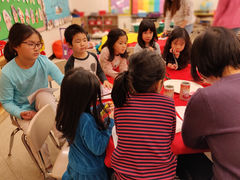
CHINESE BRUSH PAINTING
Mission:
Promotes Asian art appreciation to the world. We present you with traditional and modern Asian art that captures the spirit, cultural complexity and charm of Asia.
About Teacher:
Ms. Wei has been practicing Chinese calligraphy and brush painting for more the 20 years, and learned from a few teachers. She paints in both traditional Chinese and Ling-nan Styles. She also has knowledge in watercolor painting. She has attended the Sumi-e show in Maryland and Canada a number of times and other shows in the field of calligraphy and brush painting in Maryland. Ms. Xiao is a member of the Sumi-e Society of America, Inc., and The Chinese Culture and Art league. She has her art studio to teach students.

Give us a call:
1-240-481-3382
In The News:
New school site will be opened at Bayard Rustin Elementary school started on January 2nd, 2020
Aug 17, 2020
Eloquence class has been opened at Hope Chinese School Gaithersburg and Rockville Campus.
Feb 2, 2019
EduCIASP
EduCIASP will open new school sites at Wayside and Mcnair ES started on September 3rd, 2019.
Feb 1, 20219
/////////////////////////////////////////////////////////////////////////////////////////////////////////////////////
/////////////////////////////////////////////////////////////////////////////////////////////////////////////////////
History:
From Han (202 BC) to Tang (618-906) Dynasties, artists painted many detailed, elaborate portraits of the royal court. Some of the ancient works depicting court lives of emperors, their ladies, and imperial horses have been preserved in tombs and burial sites. Tang Dynasty also saw the beginning of landscape paintings, often referred to as "Shanshui" ("mountain water”) paintings. These are less precise and allowed for individual freedom in interpreting the subjects.
The time from the Five Dynasties period (220-960) to the Northern Song period (960-1127) is known as the “Golden Age of Chinese Landscape Painting”. Using bold strokes and black lines, artists depicted rolling hills, rivers and stones. Others used softer brushwork to paint peaceful scenes of nature, birds and animals.
In Song Dynasty (960-1279), landscape paintings almost attained a mythical quality with blurred outlines of mountains and mists.
During Yuan Dynasty (1279-1368), painters began adding poetry and calligraphy to their works to express their thoughts and feelings.
Color printing techniques perfected during Ming Dynasty (1368-1644) allowed for illustrated books and manuals on the techniques of Chinese painting.
In the 1700s and 1800s, wealthy patrons nurtured and encouraged new works by promising artists. Some large cities such as Shanghai and Yangzhou became art centers.
Western art exerted their influence on China in the late 1800s and 1900s. Some painters, after studying abroad, returned to their homeland and incorporated the best of both cultures in their art.
Session:
Fall & Spring, each session eight Classes
Time:
Monday and Tuesday from 4:15 to 5:30 PM
Location:
Monday at Matsunaga Elementary School at 13902 Bromfield Rd, Germantown, MD 20874
Tuesday at Fallsmead Elementary School at 1800 Greenplace Terrace, Rockville, MD 20850
Tuition:
Students from EduCIASP $100: Students from outside of EduCIASP $180 and materials included
Continue Educonnects Online Chinese learning Program - Click Here
/////////////////////////////////////////////////////////////////////////////////////////////////////////////////////
/////////////////////////////////////////////////////////////////////////////////////////////////////////////////////


















































